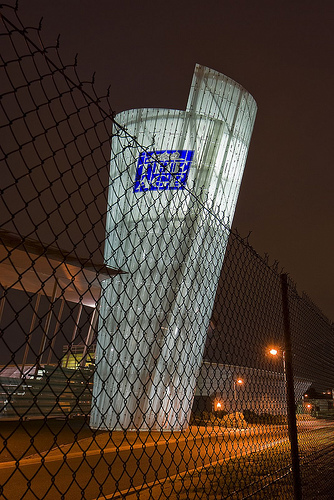In Melbourne last week we experienced three tremblers. One took me by complete surprise. It was a 5.3 magnitude earthquake that made me wonder if I was back in Japan (I was there for the big one in 2011) and had me promptly enacting my Japanese evacuation plan. The other two sent waves of aftershocks across our media. Sitting at my desk however, I didn’t feel a thing. Two of our biggest print media players (Fairfax and News Ltd) announced last week that they must finally change their publishing models, to reduce their print circulations, to pay wall their online content and to restructure their organisations. All, of course, are responses to the new media landscape: an undeniable transformation of the way we consume content. Yet the wider Australian media was filled with stories of shock and awe. This surprised me.
Just days before the announcements I’d passed by the print-complex of Fairfax’s Victorian masthead at Tullamarine, The Age. My eye traveled up their bold, signature sculpture toothed with shards of glass. The shape was ablaze with inner florescent lights, and stamped with a logo that tilts its hat to newspapers past. The building was opened just nine years ago, but the shape of the signature sculpture – that of a rolled up newspaper – now seems positively twee. When it was finished in 2003 this homage to print media was already on shaky ground. New media was undermining the paper’s gold-leaved classified sections. Portals like seek.com.au and realestate.com.au were well underway.
Which is why I’m surprised by the surprise. We talk constantly about new media and how it is a change as significant to our societies as Gutenberg’s printing press was. Of course, job cuts are a part of the shock, and these are always terrible. I don’t question the shock and anger of people losing their jobs. But surely it was clear that the numbers couldn’t add up. These monoliths were now without classified incomes and yet were somehow providing news for free online. Did we really think it was financially viable for this to occur forever? That’s like expecting to pay only when you eat in at a restaurant, but feeling fine about getting home-delivery for free.
But what does it all mean to writers of long form non-fiction? Clearly, the chances of a job writing for such a masthead are unlikely. But we knew that already. Ultimately the shake-ups at these institutions are good news because they open the field up. Without these habitual mastheads readers may begin to explore new ways of accessing our work. Writers with more clout might now step out from behind the old monoliths and join us in the new media galaxy. These combined may bring more readers to our new publishing channels.
Though current reading habits are shaped around accessing free content, introducing pay walls changes this. Once asked to pay, some readers will look elsewhere for the kind of writing they prefer. And if it’s long form non-fiction, they might just look at options such as self-published articles, community funded reporting or crowd funding pieces that they want to read. It’s still a challenge for newer writers to get their work to readers, but the breakdown of institutions does chip away a little at the barriers to entry that have developed as organisations like Fairfax and News have tightened their belts over the past decade.
The loss of jobs for workers at both organisations aside, these changes do provide other benefits for emerging writers. Some of the expertise that is currently siloed in these institutions will now be out in the free market. A higher calibre of free-ranging journalist can only lift our game. Plus, they might avail their writing and publishing talent to help new publishing initiatives succeed (a good example of this is long form non-fiction writer, Dan Baum, who has signed on to help edit on crowd-funded and soon-to-be-launched long form masthead Matter.com).
The changes at Fairfax and News are the kinds of seismic shifts needed in the Australian media landscape to rattle writers and readers into the new media galaxy. Shifting these centuries-old tectonic plates may well mean good news for us.


